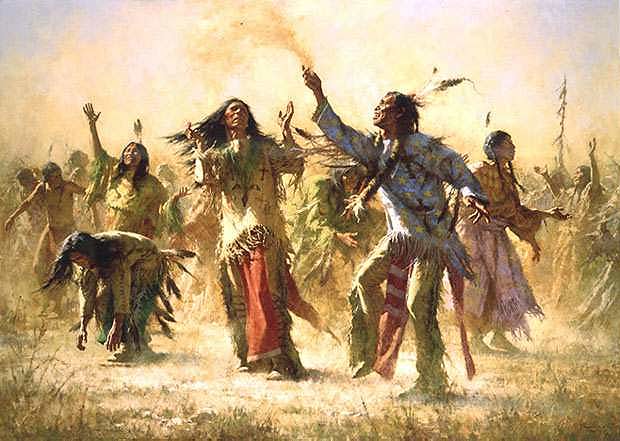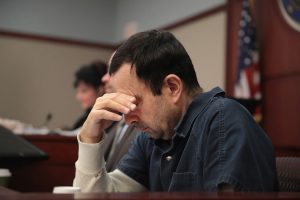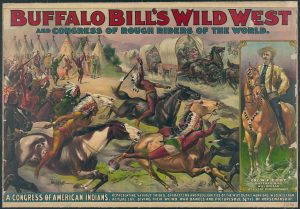The Ghost Dance, introduced by the Northern Paiute tribe, was a ceremony that acted as a hope to bring back prosperity and liveliness to all of the natives who had fallen under attacks and displacements from their homelands by white American settlers. These Ghost Dances sought to unify the tribe and bring their people together in the hope of returning to their previous ways of living; it was through this Ghost Dance that a strong connection to the spirit world was maintained. Dating back to its beginning in Nevada in 1869, the Ghost Dance was introduced by the visions of the prophet Tävibo, a Northern Paiute. He spoke of a time when Indians would once again be prosperous and no longer be under the control of white people, claiming that white people would disappear altogether. This would allow native Americans to return to the life they once had before the Europeans came, and their buffalo would once again be plentiful. This was the wish many Indians held, to return and resume to act in their cultural ways with no interruption. Tävibo also claimed that in introducing the Ghost Dance, he had spoken to their deceased ancestors. He claimed that it was these dead family members who contrived and shaped the dance into a circular performance dance ceremony. This supposed interaction with the dead and their overall influence on the living is how the name of the practice came to be called the Ghost Dance. The dance grew in popularity as it spread throughout the land, over the great plains to Nevada and California, and even to Oregon.1

During the following years, other prophets emerged, but the Ghost Dance did not continue to see widespread appeal until the appearance of another prophet, said to be Tävibo’s son. His name was Wovoka, but he was also known as Jack Wilson. Wovoka was born into the Northern Paiute tribe, but at age fourteen his father died. This left Wovoka to be raised by a white family, on the nearby ranch. By joining David Wilson’s family, Wovoka worked on the ranch and was given the name of Jack Wilson. He become accustomed to many new ways, such as the English language and the Christian religion. While he lived under this new household for years, as he became an adult he rejoined the Paiute tribe. In time, he too was said to experience visions from a higher power, or supreme being, and he spread his teachings among the tribe. Wovoka preached that his people should learn to live peacefully, for the time being, with the newcomers. Just as Tävibo had done, Wovoka also introduced dances and songs thought to have been passed on from their Indian ancestors. Wovoka expressed that if these ceremonies were performed, and if they exhibited their practices of peace, then their land too would become free of white people. Not only would a banishment of the white Americans come, but Wovoka also claimed there would be a resurrection of the deceased, and that all would be reunited with those who had passed.2
The dance would last for four days; it was a round dance that united the entire tribe. During the dance some would take fans that were woven from the wings of eagles and fan those partaking in the round dance. This act was said to put the dancers into a trance, and while submerged, those in the trance would see their relatives who had passed on to the afterworld. The dancers would see them in a place of complete serenity. The lives they were living were the ones of the past where all were happy and under no oppression, with the supply of buffalo easily at hand.3
Those who followed the teachings of Tävibo were not necessarily followers of Wovoka. But in contrast to that, the Ghost Dance was welcomed among the Plain tribes across many states, including Kansas, Oklahoma, Nebraska, Texas, and the Dakotas. The words and practices of Wovoka reached as far as the Cheyenne, Arapaho, Kiowa, Wichita, Caddo, and Apache tribes. The numbers of those participating in a single ceremony often exceeded three thousand, as groups gathered to dance every night for two weeks during a single Ghost Dance. The greatest influence reached the Lakota Sioux, who brought the dance into practice. Wovoka was consulted and listened to by the Sioux, and they took his message to heart. By 1890, Wovoka was speaking of the Ghost Dance bringing about the resurrection of their deceased ancestors. He also claimed that herds of buffalo would return in abundance, and that whites would not only leave, but would be annihilated by natural disasters, leaving Indians to their peaceful solitude once again. All wished to return to the life before any contact with the Europeans had occurred. The message that the Ghost Dance was trying to fulfill was not of hatred or rebellion, but one of returning their people to the culture and life they had enjoyed before the coming of white settlers. The Ghost Dance gave them hope that such times were yet to come. These tribes were suffering dreadful conditions, which had been forced on them, forcing them to reside in ever narrowing reservations. The Lakota people were the ones who went beyond the dance and even introduced adding special garments to the Ghost Dance ceremony. They began wearing ghost shirts that were adorned with symbols. But these shirts were not only considered a matter of simple decor, but were thought of as pieces of protection. It was a belief of the Lakotas that these shirts would resist harm from coming to them, and that even bullets would not penetrate these shirts.4

As more white citizens became aware of the Ghost Dance ceremonies being practiced by tribes around them, they sensed a threat by them and became alarmed. The U.S. Indian Policy, more specifically The Dawes Act, was believed to have been under attack by these dances and it created a fear among the white people of an uprising from the Indians. It is even said that officials, especially those who ran the reservations, saw that a war was being ignited by the Lakotas. Even the act of wearing the decorated shirts in practice of the dance fomented the idea that the Lakotas were forming and instigating the makings of a battle. In fear, the officials of the reservations called on the United States government. The president at the time, Benjamin Harrison, responded by sending the U.S. Army down to these reservations to stop the threat, hoping to end the potential conflict that was believed to be rising between the Indians and whites. This resulted in Indian leaders, such as Sitting Bull, being arrested and, unfortunately in this act, killed.5
On December 23, 1890, the Miniconjous Lakotas fled and escaped their reservation village after being struck with fear. From the words of John Dunn, a local squatter, the military had planned to take the Lakota men and deport them to an island in the Atlantic Ocean. With this news, the Miniconjous Lakotas ran, but after five days, the tribe was found by the Seventh Cavalry, who were sent to intervene. The Lakotas were sent to reside in confinement on Wounded Knee Creek. By the next morning, December 29, Colonel James W. Forsyth ordered that the tribe surrender all firearms. In back and forth arguments, some Lakotas engaged in the songs of the Ghost Dance. Once again, the Ghost Dance was interpreted as a threat. Some Indians began throwing handfuls of dirt in the air, and this was seen as a signal of attack. This ignited the soldiers who were supervising the reservations. In a quarrel over a rifle, Black Coyote refused to surrender his gun to a soldier who had demanded it. During the tug of war and struggle to get the gun, it accidentally fired. Because of this sudden shot, troops opened fire because they were under the assumption that they were indeed under attack and needed to regain order. The Lakotas, who had no weapons, did all they could do to flee the situation. The military fired their weapons and chased down all that attempted to escape, killing along the way. The gunfire continued for hours as the military pursued the Lakotas. This occurrence became known as the Wounded Knee Massacre. Between 145 to 300 Indian followers died, many of these victims being women and children. In the attempt to gather all bodies, some were found even three miles away from the reservation. One-hundred-forty-six Lakotas were buried in a mass grave, while the others were gathered and accounted for later.6

While the military lost only twenty-five men, it was celebrated among the white people as a success. People believed that the “savage ways” of the Indians may finally be over. The Medal of Honor was presented to twenty individuals for their acts during the massacre at Wounded Knee, as their actions was seen as being extremely heroic. The Wounded Knee Massacre was the final blow to the Indians as this ended the four hundred year conflict between the whites and the natives. In only ten years, the Indian population reached a low of 250,000 people. This massacre resulted in the Ghost Dance ceremonies dying out among the Lakotas, but elsewhere in the plain, the acts continued. In some areas as far away as Canada, the Ghost Dance was practiced well into the 1960’s. The ceremonial Ghost Dance holds a rich cultural importance to all of those who were a part of it. It was an expression of native tribes longing for the return of their happy, prosperous, and unbothered lives before the introduce of white settlers. It shows the practice as being completely connected with ones spirituality, in that it reunites members to those who have passed. It highlights how important culture is to native Indians by the acts of dancing, singing songs, and the clothing they put on their bodies. The true purpose of these Ghost Dances was to inspire hope, and it continues to do so in that it shows that even today this Indian culture should not die out as time progresses.
- Encyclopedia of The Great Plains, 2011, s.v. “Ghost Dance,” by Todd M. Kerstetter. ↵
- Encyclopedia of The Great Plains, 2011, s.v. “Ghost Dance,” by Todd M. Kerstetter. ↵
- Salem Press Biographical Encyclopedia, 1995, s.v. “Wovoka,” by Ronald W. Long. ↵
- The Encyclopedia of Oklahoma History and Culture, 2009, s.v. “Ghost Dance,” by Gloria A. Young. ↵
- The Encyclopedia of Oklahoma History and Culture, 2009, s.v. “Ghost Dance,” by Gloria A. Young. ↵
- Encyclopedia of The Great Plains, 2011, s.v. “Wounded Knee Massacre,” by John E. Carter. ↵



97 comments
Maggie Trujillo
I had heard of The Wounded Knee Massacre, but don’t remember learning about the Ghost Dance and some other interesting parts of what happened if it wasn’t for this article. This article included a lot of detail of what happened and was able to describe it very thoroughly. There were many interesting points that I read in this article that I didn’t know about; such as Tävibo (aka Jack Wilson) living with a white family and then going back into his tribe after several years. The other interesting point was the wearing of the ghost shirts and how they believed that the shirts could even stop a bullet from harming them. The author did a good job incorporating these interesting facts into their article.
Maria Luevano
I really enjoyed reading this article since I like reading about Native Americans and their culture. I have heard about the Ghost Dance before but had never read something as detailed about it as this article. It is disappointing that white settlers found this dance to be threatening instead of embracing their unique culture dance, they had no reason to suppress native Americans or their culture.
Tabitha Babcock
I loved the way you structured this article, by first telling us about how the ghost dance came to be, then the importance of it, and then the misunderstanding and ultimately the massacre. It’s really sad that the Indians just wanted to be at peace again, to get rid of the white people in a nonviolent way, and felt that so deeply that they expressed it through dance and ritual, and it never happened. Still today indigenous people have barely any land to call their own, dismal reservations compared to what is all rightfully theirs.
Danielle Sanchez
This article did a phenomenal job describing the Ghost Dance and providing images to glide the story along. The Ghost Dance gave Native Americans a sense of hope that one day the white man would leave their homelands. The dance would unite the tribe and put them into a trance which led them into the underworld. The ghost dance was meant to be peaceful; it was a dance of hope. Out of fear the president sent the U.S. Army which ended the peace. Great job with the article!
Ian Poll
This article really puts into perspective how disconnected the white people were from the Indians. The twenty white men who were killed were treated as heroes while unarmed and innocent Indians were killed and just dumped together and not given a second thought other than the white’s perspective of them as wild animals. Good job on the article and the details into the background and cause of the massacre.
D'vaughn Duran
Great information and setting up paragraphs! This article was about a great topic to cover. The ghost dance and how it first started with the meaning of why it’s important made the article a great read then bring the horrible massacre. I never heard of any of these events so this was an eye opening for me to read and react to this article. Thank you for spreading this information, giving context of these events that led up to and with what happened.
Andrea Tapia
The article showed a well view on the Ghost Dance and what the Wounded Knee Massacre was all about. The Ghost dance had a special touch to how much it meant to the Native Americans by bringing their people together, hoping to return to their previous ways. They had such a strong connection with each other and even with their deceased ancestors. All they wanted was to live without white Americans and be able to gain their life back the way it was before. I do believe the Ghost dance was very powerful within their culture and is an important mark in history to remember them by and what they still face with today.
Gabriella Galdeano
This article was very well-written. The Ghost Dance sounds like it was a beautiful representation of Native American culture. It is sad how a lack of understanding of the Native American culture led to the Wounded Knee Massacre. The author is correct in saying that Indian culture should be kept alive. The story behind the Wounded Knee Massacre is important and needs to be shared. Many people do not know the importance of the Ghost Dance but should as a way to help keep it alive.
Karlo Collazo
The article by Gabriela Serrato is a reminder of the ongoing hardships natives still have to face today. Serrato states a tragic event that happened with natives so clearly to the point where the reader can sympathize with the people who were involved. From the informative introduction to the emotional, unfortunate, outcome of the conflict between white people and natives, Gabriela does a great job of “freezing” time and explaining to the audience what emotions spiraled before, during, and after the tragic massacre.
Veronica Lopez
Interesting article! I really explains the Native American culture and how it’s been “criticized” throughout history. I found it fascinating how easily the white citizens got scared of the Ghost Dance because they didn’t know the meaning behind it. There’s been many cases where these persecutions happen and it ends in tragedy. The Wounded Knee massacre is a prime example of what happens when people are scared of the unknown.